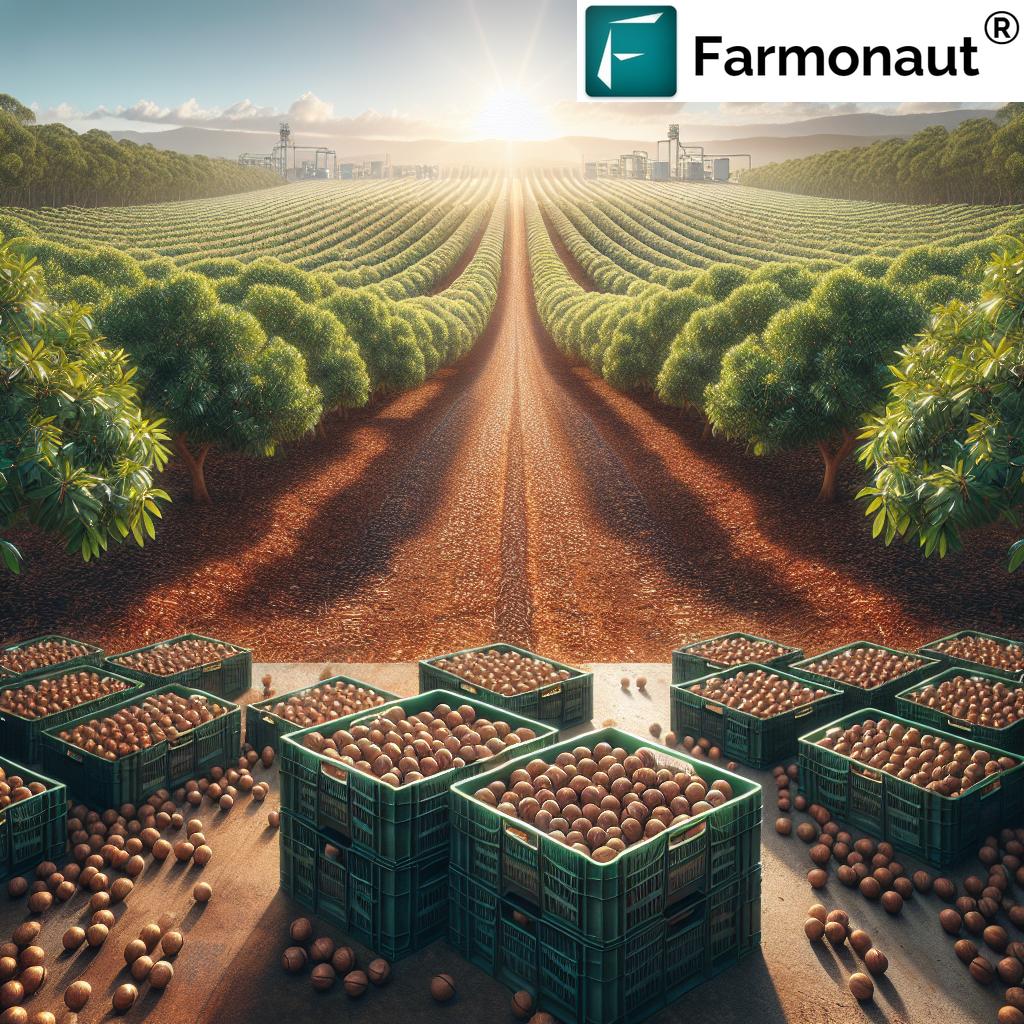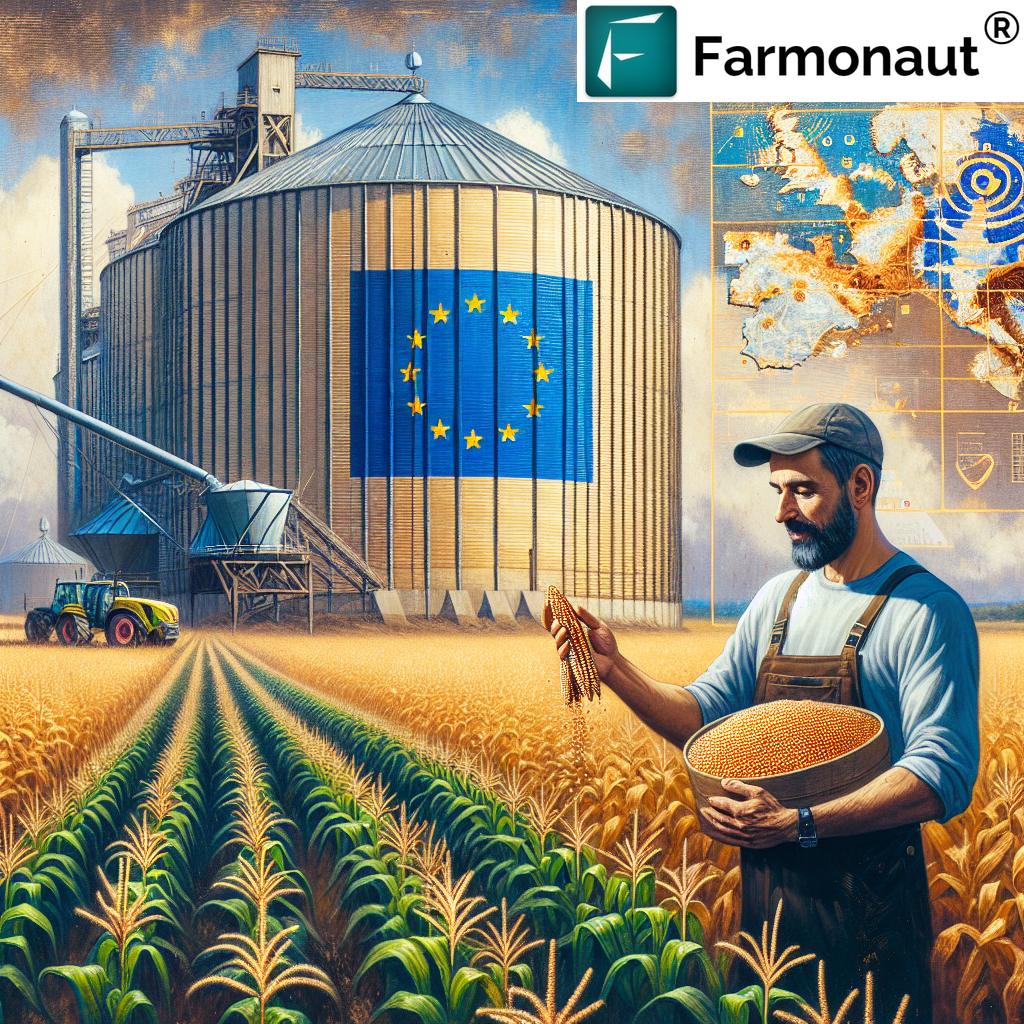Macadamia Market 2024: Shocking Growth Secrets Revealed
- The Macadamia Market: An In-Depth Analysis
- Global Macadamia Nut Production & Leading Producers
- Global Macadamia Market Overview Table
- Macadamia Nut Demand, Consumption & Market Dynamics
- Macadamia Industry Trends 2024: Processing, Products & Key Players
- Macadamia Market Challenges & Environmental Sustainability
- Macadamia Market Outlook & Future Trends
- Farmonaut Solutions: Driving Sustainable Macadamia Farming
- Frequently Asked Questions (FAQ)
- Conclusion
The Macadamia Market: An In-Depth Analysis
As we delve into macadamia market growth for 2024, it becomes clear that the global landscape of this premium nut is set for remarkable expansion. With rising demand fueled by increasing health consciousness, the popularity of plant-based diets, and the unparalleled versatility of macadamias in food, cosmetic, and even industrial applications, the industry is at a pivotal point. In this comprehensive article, we cover macadamia production volumes, emerging consumption trends, leading producers, key players, sustainability imperatives, and the future outlook. The data and analysis provided here are meant to give all stakeholders—from farmers and exporters to health-conscious consumers and investors—vital insights into this dynamic sector.
Macadamias, originally native to Australia, have witnessed global adoption, expanding into Africa, Latin America, and Asia. From their humble beginnings, macadamias have grown into a staple for healthy snacks, specialty foods, and high-value export commodities. What are the shocking growth secrets behind their success in 2024? Let’s explore the underlying factors driving this incredible journey.
Global Macadamia Nut Production & Leading Producers in 2024
Understanding global macadamia nut production is fundamental to grasping the entire market landscape. Recent estimates indicate that as of 2024, total production reached an estimated 338,000 metric tons (in-shell). This figure highlights continuous expansion and diversification of cultivation areas across the globe.
Who Are the Leading Macadamia Producers?
- Australia: Undisputed as the primary global producer and largest exporter (by volume and value), it alone accounts for over 70% of the country’s production from Queensland. Major expansion projects, particularly in the Bundaberg region, have contributed to a steady rise in output.
- South Africa: Now rivalling Australia, with projected output of around 92,000 metric tons in 2024. The maturation of orchards established after the late 2010s underpins this impressive rise.
- Kenya: Leading East Africa, Kenya’s macadamia production topped 15,000 metric tons in 2024 despite challenges like unpredictable weather and disease.
- China: No longer just a consumer, China is ramping up domestic cultivation and processing, aspiring to reduce imports while becoming a significant regional player.
- Guatemala: Latin America’s most prominent contributor, gradually increasing both output and export potential.
The expansion of macadamia orchards in Queensland (Australia), new plantations in South Africa, and growing investments in Kenya and Latin America are shaping the dynamics. The diversity of climates and production systems impacts everything from nut quality and yields to sustainability and market volatility. Accurate production statistics not only inform investors but also underpin effective supply chain and resource management decisions.
With these impressive results, Australia and South Africa together now produce over 50% of the world’s macadamia nuts, leading the industry in 2024.
Changes in production volumes are closely linked to weather conditions, the impact of El Niño, and environmental management. Countries like Kenya face dry and hot weather jeopardizing flowering and yields. This underscores the growing need for advanced farm management and sustainable practices—a segment where leading technologies like Farmonaut play a decisive role.
Global Macadamia Market Overview Table
| Country | 2024 Estimated Production (MT) | 2023-2024 Growth Rate (%) | Main Export Markets | Sustainability Highlights |
|---|---|---|---|---|
| Australia | ~55,000 | +6.8 | China, Japan, USA, Europe | Water management, habitat preservation, organic farming |
| South Africa | 92,000 | +8.1 | China, USA, Europe | Integrated pest management, technology adoption, fair-trade focus |
| Kenya | 15,000 | +5.5 | Asia-Pacific, Europe | Agroforestry expansion, smallholder empowerment, drought resilience |
| China | 12,000 | +9.6 | Primarily domestic; some exports to Asia | Domestic supply chain sustainability, orchard renewal |
| Guatemala | 8,500 | +4.2 | USA, Europe | Rainforest protection, farmer education, certification programs |
Macadamia Nut Demand, Consumption & Market Dynamics
Let’s dive into the forces shaping macadamia nut demand and macadamia consumption trends. As our market analysis reveals, 2024 is set to be a breakthrough year for both traditional and emerging markets.
Asia-Pacific: Dominant Market Position & Demand Surge
- Asia-Pacific holds a dominant global market share of over 50% in 2024, with China as the standout market.
- Chinese demand is projected to increase to 46,500 metric tons by 2027—2.7x the 2022 amount—thanks to robust growth among young consumers and the inclusion of macadamias in an array of food products and snacks.
North America: Expanding Consumption & Nutritional Demand
- The United States remains a major importer (USD 197 million in 2022) and exporter of macadamia nuts.
- The U.S. macadamia market is valued at USD 0.4 billion in 2024, with projections indicating continued growth to USD 1.0 billion by 2035—achieving a robust CAGR of 10.1%.
Europe & Other Markets
- A growing middle class in Europe and Asia is driving rising macadamia nut demand, linked to increased health and consciousness about the nutritional benefits of nuts.
- The use of macadamias in bakery, dairy substitutes, niche butters, and even beverages is broadening market versatility.
A compound annual growth rate (CAGR) of almost 15.7% (2024–2030) means global values could reach USD 6.95 billion by 2030. The market’s dynamics arise from shifts in food industries, consumer awareness, and dietary trends—particularly the rise of healthy snacks and plant-based diets.
Key Macadamia Product Formats & Consumption Patterns
- Snacking (raw, roasted, salted, flavored)
- Baking & confectionery (cookies, chocolates, pastries)
- Butters, spreads, and non-dairy beverages
- Oil extraction, mainly for food but also for cosmetics and hair care
- Food processing ingredients (granolas, breakfast cereals, bakery pre-mixes)
The versatility of macadamias as healthy snacks and functional ingredients is central to their popularity with both young and older consumers alike.
Macadamia Export Statistics: Key Insights
- Australia: Remains the world’s top macadamia exporter, sending large quantities to China, Japan, the U.S., and Europe.
- South Africa: Gaining share, especially in the Chinese and U.S. markets.
- Kenya, Guatemala, China: Rapidly scaling up exports and domestic processing capabilities.
Macadamia Industry Trends 2024: Processing, Products & Key Players
Who Are the Key Players & Innovators?
- Hawaiian Host Group – A leader in branded nut chocolates and snacks, driving quality innovations in the U.S. and Asia.
- Health and Plant Protein Group Limited – A major Australian macadamia processor investing in scale and new products.
- Hamakua Macadamia Nut Company – Hawaii-based, focusing on specialty snacks and value-added processing.
- Mac’s Nut Co. of Hawaii – Specializing in diverse product lines and exports.
- Golden Macadamias (South Africa) – Advanced technology adoption, recently implementing TOMRA 5C automated sorting with Biometric Signature Identification to improve food safety and efficiency.
Many of these companies are accelerating R&D in provenance, new flavors, sustainable processing, and tracing product journeys for global consumer trust.
Technology Transforming Macadamia Market Growth
- Smart Sorting & Quality Assurance: AI-enabled machines optimize nut processing efficiency and product quality.
-
Supply Chain Traceability: Blockchain adoption (see Farmonaut’s traceability solutions
) ensures transparency and reduces counterfeit risks in global exports. - Carbon Footprinting: Sustainability is supported by Farmonaut’s carbon emission tracking tools —enabling exporters and farmers to quantify and reduce environmental impact.
- Satellite-Based Management: Technologies like the Farmonaut Large Scale Farm Management App help macadamia farm managers oversee vast orchards with precision, tackling challenges such as pest outbreaks and irrigation control.
Product Innovation: Meeting Rising Consumer Demand
- Flavored & Functional Snacks: Macadamias are now available in spicy, sweet, herbal, and health-boosted variants.
- Plant-Based Dairy & Baking Substitutes: Macadamia milk, cheese alternatives, and gluten-free flour blends feed into plant-based diets.
- Cosmetics: Macadamia oil features in premium skincare and haircare, valued for its moisturizing benefits.
Segmenting the Market by Application
- Food & Beverage (dominant)
- Cosmetic & Personal Care
- Pharmaceutical & Nutraceutical
- Animal feed (byproducts)
Macadamia Market Challenges & Environmental Sustainability
Market Challenges Impacting Future Growth
- Disease Management: Macadamias are susceptible to root rot diseases (notably caused by Phytophthora cinnamomi and Armillaria mellea), leading to significant tree mortality and costly replanting.
- Slow Orchard Maturation: Macadamia trees mature slowly (often 5–7 years), leading to delayed returns and market volatility.
- Environmental Factors: Hot, dry, and unpredictable weather conditions (including El Niño and drought) can devastate flowering and yields.
- Market Volatility: Rapid shifts in demand and large-scale investments occasionally lead to oversupply fears and price corrections.
- Supply Chain Inefficiencies: Under-mechanized farms and logistical bottlenecks increase postharvest losses.
Sustainable Macadamia Farming & Resource Management
- Water Management: Intensive macadamia cultivation in Australia and South Africa demands responsible water usage. Advanced satellite tracking & resource management apps are critical for reducing wastage and supporting sustainable growth.
- Land Use: Expansion leads to land clearing and potential habitat loss. Many producers pursue certification (e.g., organic, fair-trade).
- Climate Adaptation: Agroforestry, drought-resistant rootstocks, and AI-based advisory systems (like Farmonaut’s Jeevn AI) support yields against unpredictable environments.
Experienced growers increasingly adopt the principles of sustainable macadamia farming—embracing efficient irrigation, carbon accounting, and traceable supply chains to stay ahead of regulations and meet consumer expectations for ethical sourcing.
Macadamia Market Outlook & Future Trends
Market Projections & Key Growth Drivers
- Projections indicate the global macadamia market will reach USD 6.95 billion by 2030 (CAGR ~15.7%). Demand from health-conscious consumers and a shift towards plant-based products are pivotal.
- Emerging Markets: Southeast Asia, Middle East & North Africa increasingly value macadamias for both cuisine and confectionery segments.
- Technological Innovation: Faster adoption of smart processing, digital orchard management tools, and advanced weather analytics empowered by Farmonaut’s farm management platform.
- Supply Chain Transparency: The integration of blockchain traceability solutions is expected to become standard, raising trust and efficiency in global macadamia exports.
- Resource Efficiency: Data-driven fleet and resource management tools will be crucial to dispatch and delivery operations—reducing waste while maximizing profits.
Innovations Shaping the Future of Macadamia Farming
- AI Advisory Tools: Real-time recommendation systems, such as Farmonaut’s Jeevn AI, help farmers adapt under changing weather conditions, manage pests, and make smarter input decisions.
- Satellite-Driven Monitoring: Frequent, cost-effective monitoring for crop health (NDVI), soil moisture, and stress events—see Farmonaut Large Scale Farm Management.
- Carbon Footprinting Solutions: Tools like Farmonaut’s carbon monitoring allow farms to measure, reduce, and report emissions, supporting both sustainability and market access.
- Insurance & Credit Access: Satellite-based verification for crop loans and insurance opens doors to finance, especially for smallholder macadamia growers.
Sustainability Mandate for the Next Decade
- As global buyers and consumers demand eco-conscious practices, certifications (fair-trade, organic) and open reporting on water, labor, and emissions will decide market access and price premiums.
- Emphasis on youth and smallholder empowerment, especially within Kenya and Guatemala, will shape the social footprint of macadamia expansion.
Get Started with Farmonaut’s Subscription Plans
Farmonaut offers cost-effective, scalable subscription solutions for farm management, carbon footprinting, resource optimization, and blockchain traceability in the macadamia segment and beyond:
Farmonaut Solutions: Driving Sustainable Macadamia Farming
At Farmonaut, our vision is to make precision agriculture affordable and accessible worldwide. How does this support the macadamia industry trends 2024 and address sector-specific challenges?
- Satellite-Based Crop Monitoring: Using satellite imagery and analytics, we provide insights into vegetation health (NDVI), soil moisture, drought stress, and more—perfect for large macadamia orchards in Australia, South Africa, and Kenya.
- AI-Driven Advisory Systems (Jeevn AI): Our Jeevn AI delivers real-time, location-specific advice on weather, pests, and input application, tackling the crop management issues common to the macadamia segment.
- Blockchain Traceability: Farmonaut’s blockchain solutions create end-to-end transparent supply chains for export, food, and even cosmetic products. This meets buyer demands for sustainable macadamia farming and product integrity.
- Resource & Fleet Management: Our fleet management tools help agribusinesses manage vehicles, logistics, and fertilization/harvest operations, raising efficiency and reducing environmental impact.
- Carbon Footprint Tracking: Farmonaut’s carbon tracking tools support farmers, cooperatives, and exporters to monitor and lower emissions, enhancing sustainability credentials.
- Insurance & Credit Verification: Satellite monitoring for crop loan and insurance verification de-risks agricultural finance, letting macadamia farmers access credit more easily at better terms.
Our technology suite (starting from just a few hectares upwards) ensures macadamia producers and processors keep ahead in a data-driven, globally competitive environment.
Harness the power of Farmonaut APIs or see technical documentation at Farmonaut API Developer Docs to integrate agriculture data directly into your business software, portal, or ERP.
Frequently Asked Questions (FAQ)
-
What is the estimated global macadamia nut production in 2024?
Approximately 338,000 metric tons (in-shell) worldwide, with Australia, South Africa, and Kenya leading. -
Who are the largest macadamia producers and exporters?
Australia is the largest exporter and leading producer, followed by South Africa, Kenya, China, and Guatemala. -
Which region accounts for the largest share of macadamia consumption?
The Asia-Pacific region dominates global macadamia nut demand, with China’s consumption rising sharply. -
How fast is the global macadamia market growing?
The market is projected to grow at a compound annual growth rate (CAGR) of about 15.7% (2024–2030), reaching a value of USD 6.95 billion by 2030. -
Why is sustainability a concern in the macadamia industry?
Rapid expansion creates water, land, and climate challenges. Sustainable farming, resource management, and traceability are needed to protect the environment and meet global buyer expectations. -
How can technology help overcome challenges in macadamia production?
Satellite monitoring, AI advisory, blockchain, and carbon footprinting (as offered by Farmonaut) support precise management, reduce risks, and enhance supply chain transparency. -
What are the main uses of Farmonaut’s solutions in macadamia farming?
They include crop health monitoring, resource management, traceability, carbon tracking, and farm management for individual growers and large agribusinesses.
Conclusion
The macadamia market growth in 2024 is nothing short of extraordinary, shaped by rising nut demand, global expansion of production, and ever-evolving industry trends. As we have explored, the sector is characterized by healthy competition, innovation, and environmental challenges.
With Farmonaut’s advanced solutions—from satellite-driven monitoring and AI-advice to blockchain traceability and carbon accounting—producers and agribusinesses are well-equipped to meet both production imperatives and sustainability mandates. By combining technology and good agricultural practices, the future outlook for macadamia nuts remains exceptionally bright.
Whether you’re a grower, exporter, processor, or health-conscious consumer, staying informed about the latest macadamia industry trends 2024, market dynamics, and future projections is the key to harnessing the full potential of this ever-growing segment.
Check out Farmonaut’s platform for affordable, scalable, and sustainable farm management—and let’s shape a more prosperous, responsible, and innovative macadamia market together.


















